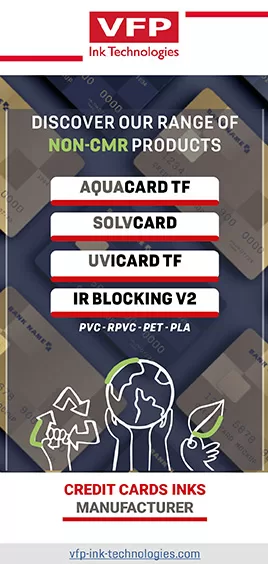
by Jennifer Kohlhepp | CM Magazine Featured
ISO Standards Update
At the ICMA EXPO last year, I advised those who attended my presentation that we were on schedule to issue a substantially revised ISO/IEC 24789 Card Durability Standard by year end. In fact, both parts of this revised standard were published earlier this year on January 8.

A primary objective of this revised standard is to provide a deterministic test plan for a particular card application and its intended usage. It relies less on long, sequential tests used in the current standards with substantial changes in both methodology and testing. The premise is that two, or more, independent test labs come to the same conclusion of the appropriate test suite. Test parameters for most methods to be included in a test plan suite are determined from card functional elements, the number of uses per day and expected lifetime (years). Test sequences in the test plan have been shortened with a limit of three methods in any test sequence. Test parameter calculations are only based on the usage factor (uses/day) and expected lifetime (years). The complex calculations using environmental, storage and reader factors of the current standard have been eliminated.
Some changes in the tests themselves are also included. Most notably, the Temperature and Humidity cycling method has been replaced by Temperature Exposure with Humidity Variation method. DOTP replaces DOP as the plasticizer material used in the Plasticized Vinyl Storage test method. The Temperature and Humidity Aging followed by Peel Strength sequence testing has been eliminated. Wear and Soil (now called “Soiling Test” with a new apparatus and method), UV Light Exposure and Shortened Bending Stress tests have been moved to an Informative Annex as optional test methods. Also, new Mechanical Life Cycle Sequence test method and apparatus for contactless IC cards, Card Static Stress and Temperature and Humidity Induced Dye Migration test methods have been added as options in the Informative Annex. Standalone and sequence tests are also more fully described and explained.
Overall, most tests have been enhanced to take advantage of improved technology since the previously published 2012 standard. Improved clarity of test methods with better diagrams also enhance understanding of the standard. Undoubtedly, this revised standard will also undergo further revisions over time as technology and knowledge improve. However, this revision achieves its primary goal of providing certainty of test regimes for defined card applications and their usage, that is a significant advance over the previous (2012) published standard.
While this standard is newly published, there is already continuing work on its improvement for a subsequent revision. An outline of those initiatives are as follows:
- Different forces and different number of cycles in the three-wheel test. This is the test that applies compressive force to a card micro-module.
- Card constructions with multiple modules; for example, cards with ISO/IEC 7816-2 contacts and a fingerprint sensor in another area of the card may require modifications/adjustments of the existing test methods. Continuing with this example, conducting the three-wheel test on a fingerprint module in a location different from the ISO/IEC 7816-2 contact location.
- Biometric cards in ID applications with 10+ year lifetime.
- Environmentally sustainable cards—specific tests unique to these card constructions.
- Vibratory finishing to test delamination of card bodies.
There are also initiatives in other related ISO standards, as outlined below:
- A statement of purpose for each test method to guide users as to suitability for their card applications.
- Technical guidance on notches in cards; maybe as a Technical Report instead of an International Standard since recent efforts in this area were not fully supported for a change in ISO 7811-9.
- Abrasion test methods of surface printed cards; how to adapt the Taber Abrasion test method to these kinds of cards that use Drop on Demand printing.
- ISO 7810 revision.
- The Standard has been opened for revision with a Working Draft created.
- Incorporate the ISO 7816-1 Amendment 1 into the main text. These are the physical and electrical requirements for contact card micro-modules. There are some specific requirements that are redundant and potentially in conflict between what is stated in ISO 7810 and the new Amendment 1 that incorporates 7816-1. Eliminate these competing requirements so there is neither conflict nor redundancy.
- Resistance of contacts for used cards that have corrosion versus new cards with no corrosion.
- Mechanical strength of contacts.
- IC and magnetic stripe electromagnetic interference.
There are also significant revisions occurring with ANSI/INCITS card durability, and other, standards. I will provide an update on those initiatives in a later article.
About the Author: David Tushie, ICMA standards and technical representative, has had a long and continuing career in the card industry, working for international companies such as DataCard, UbiQ and NBS Technologies. He has master’s degrees in engineering and business, holds U.S. and international patents in measurement and card issuance systems and has had several years of involvement with the ANSI, INCITS and ISO Standards process. ICMA is represented at six ISO and ANSI Standards Meetings through David’s standards role within the association.





